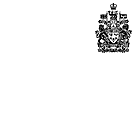

Creation and Beginnings of the Court
About the Court
Court Building
The Supreme Court building was designed by Ernest Cormier, the Montréal architect who also designed the Quebec Court of Appeal building, the Government Printing Bureau in Gatineau and the University of Montréal. Situated just west of the Parliament Buildings on a bluff high above the Ottawa River, and set back from a busy Wellington Street by an expanse of lawn, the building provides a dignified setting worthy of the country's highest tribunal.
A statue of former Prime Minister Louis S. St-Laurent (1949-57), erected in 1976, stands on the lawn in front of the building. It is the work of Vancouver sculptor Erek Imredy. There are two flagstaffs at the front of the building. The one to the west is hoisted daily. The other flag flies only when the Court is sitting.
Two tall statues have been erected on the steps of the building, "Truth", on the west, and "Justice" to the east. They were made by the Toronto artist, Walter S. Allward, creator and architect of the Canadian War Memorial at Vimy Ridge in France. At the rear, there are a fountain and a terrace overlooking the Ottawa River.
At the entrance to the building are two fluted, metallic, torch-like pillars with clusters of lighting brackets at the top. Two bronze doors give access to an impressive grand entrance hall, measuring 32 by 17 metres, and 12 metres in height. The walls are rubané marble and the floor Verdello and Montanello marble. Four marble columns along the end walls support a deep coffered ceiling.
In the Gallery, off the Grand Entrance Hall, is a bust of Sir Lyman Poore Duff, Chief Justice from 1933 to 1944 and the Court's longest serving member, having been appointed to the Court in 1906. The busts of Chief Justices Cartwright, Laskin, Dickson and Lamer, by the sculptor Kenneth Jarvis, Q.C., can also be found there together with photographs of all the judges of the Supreme Court since its establishment.
At each end of the Grand Entrance Hall is a courtroom used by the Federal Court and the Federal Court of Appeal. The walls of these two courtrooms are walnut panelled, with Australian zebrano wood pilasters trimmed with Honduras mahogany. Corridors, with Missisquoi marble floors and walls, encircle the building on the ground floor and on the first and second floors.
The Main Courtroom, reserved for the use of the Supreme Court, occupies the centre of the building on the first floor.
Public access to theMain Courtroom is by a flight of stairs on either side leading up from the Entrance Hall. At the foot of these stairs is a reproduction in bronze of the original Supreme Court Building, a gift from the Canadian Bar Association for the Court's centennial year in 1975. It is the work of Canadian artist Arthur Price. Verdello marble was used for the staircase and golden Morocco marble for the ramps. The silver bowl is the "Rosewater Bowl" donated in 1982 as a memento by the Canadian Bar Association, which had received it in 1930 from the four Inns of Court and the Law Society in England. To the left of the staircase are ceremonial robes, donated by Chief Justice Dickson.
The Main Courtroom, measuring 12 by 16 metres, has black walnut walls between fluted pilasters. Six windows, each seven metres in height, open to interior, naturally lighted courtyards which provide it with protection from outside noises. The courtroom is equipped with simultaneous interpretation equipment and a video-conference system which may be used by litigants to argue their cases from remote locations. Sound-activated automatic cameras are used to record hearings.
The Court Registry and the chambers of the Registrar and Deputy Registrar are located on this floor. The Judges' Conference Room is directly behind the courtroom.
On the third floor, directly above the Grand Entrance Hall, is the Library's main reading room.
![[Photo - Supreme Court Building]](/web/20061029064305im_/http://www.scc-csc.gc.ca/_images/display/pi_5.jpg)
![[Photo - The Statue Veritas]](/web/20061029064305im_/http://www.scc-csc.gc.ca/_images/display/pi_3.jpg)
![[Photo - The Statue Justitia]](/web/20061029064305im_/http://www.scc-csc.gc.ca/_images/display/pi_2.jpg)

![[Photo - Grand Entrance Hall]](/web/20061029064305im_/http://www.scc-csc.gc.ca/_images/display/pi_10b.jpg)
![[Photo - The Main Courtroom]](/web/20061029064305im_/http://www.scc-csc.gc.ca/_images/display/pi_10c.jpg)
![[Photo - The Judges' Conference Room]](/web/20061029064305im_/http://www.scc-csc.gc.ca/_images/display/pi_11.jpg)
![[Photo - The Library]](/web/20061029064305im_/http://www.scc-csc.gc.ca/_images/display/pi_13.jpg)